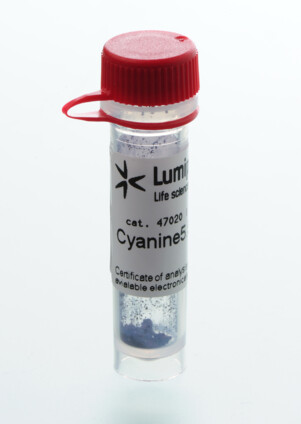Fluo-4 AM, green fluorescent calcium indicator
| Cat. # | Quantity | Price | Lead time | Buy this product |
|---|---|---|---|---|
| 1892-50ug | 50 ug |
$32
|
in stock | |
| 1892-500ug | 500 ug |
$279
|
in stock |

Fluo-4 AM is a cell-permeable Ca2+-indicator that is metabolized by intracellular esterase, leading to a bright green fluorescent signal upon Ca2+-binding (excitation/emission λ at 494/506 nm). Fluo-4 AM is used for visualization and measurement of intracellular Ca2+. It is well suited for fluorometric and imaging applications such as microscopy, flow cytometry, spectrofluorometry, and fluorometric high-throughput microplate screening assays [1].
Fluo-4 AM is similar in structure and spectral properties to the widely used Ca2+-indicator, Fluo-3, but it has certain advantages over Fluo-3, such as brighter fluorescence emission, high rate of cell permeation, and a Kd for Ca2+ in buffer of 345 nM. Because of its higher fluorescence emission intensity, Fluo-4 AM can be used at lower intracellular concentrations, making its use less toxic for live cells.
As Fluo-4 AM does not covalently bind to cellular components, it may be actively effluxed from the cell by organic anion transporters. In vivo cell imaging with Fluo-4 AM is usually performed within one or two hours after loading, but the dye can be re-loaded to cells if it is needed. Fluo-4 AM can also be fixed in situ by EDC/EDAC for downstream immunofluorescence studies.
Fluo-4 AM has low solubility in the water. It is recommended to prepare 1 mM stock solution in labeling grade DMSO prior to cell loading. Use the final concentration of 1-5 μM and incubation at 37 °C for 15-60 min as a start point of your protocol.
[1] Gee K.R. et al. Chemical and physiological characterization of fluo-4 Ca(2+)-indicator dyes. Cell Calcium. 2000. 27(2). 97-106.
Absorption and emission spectra of Fluo-4 AM (calcium-bound form)

Customers also purchased with this product
General properties
| Appearance: | orange-red powder |
| Molecular weight: | 1096.95 |
| CAS number: | 273221-67-3 |
| Molecular formula: | C51H50F2N2O23 |
| IUPAC name: | N-[4-[6-[(Acetyloxy)methoxy]-2,7-difluoro-3-oxo-3H-xanthen-9-yl]-2-[2-[2-[bis[2-[(acetyloxy)methoxy]-2-oxoethyl]amino]-5-methylphenoxy]ethoxy]phenyl]-N-[2-[(acetyloxy)methoxy]-2-oxoethyl]glycine (acetyloxy)methyl ester |
| Solubility: | good in DMSO |
| Quality control: | NMR 1H and HPLC-MS (95+%) |
| Storage conditions: | 24 months after receival at -20°C in the dark. Transportation: at room temperature for up to 3 weeks. Desiccate. |
| MSDS: | Download |
| Product specifications |
Spectral properties
| Excitation/absorption maximum, nm: | 494 |
| Emission maximum, nm: | 518 |


























 $
$ 
